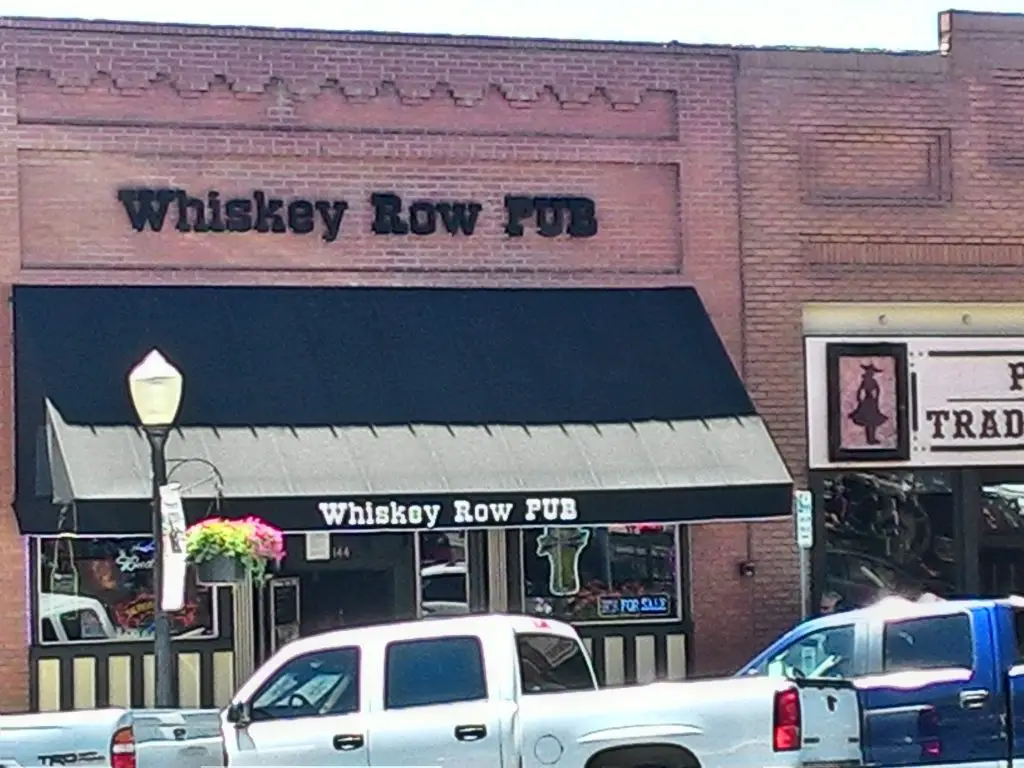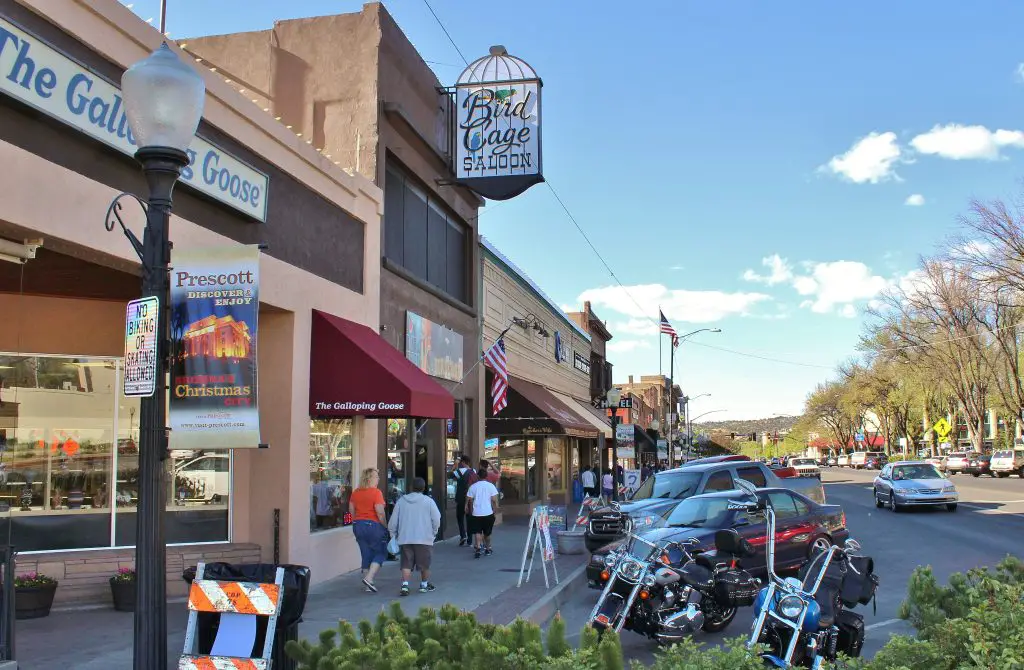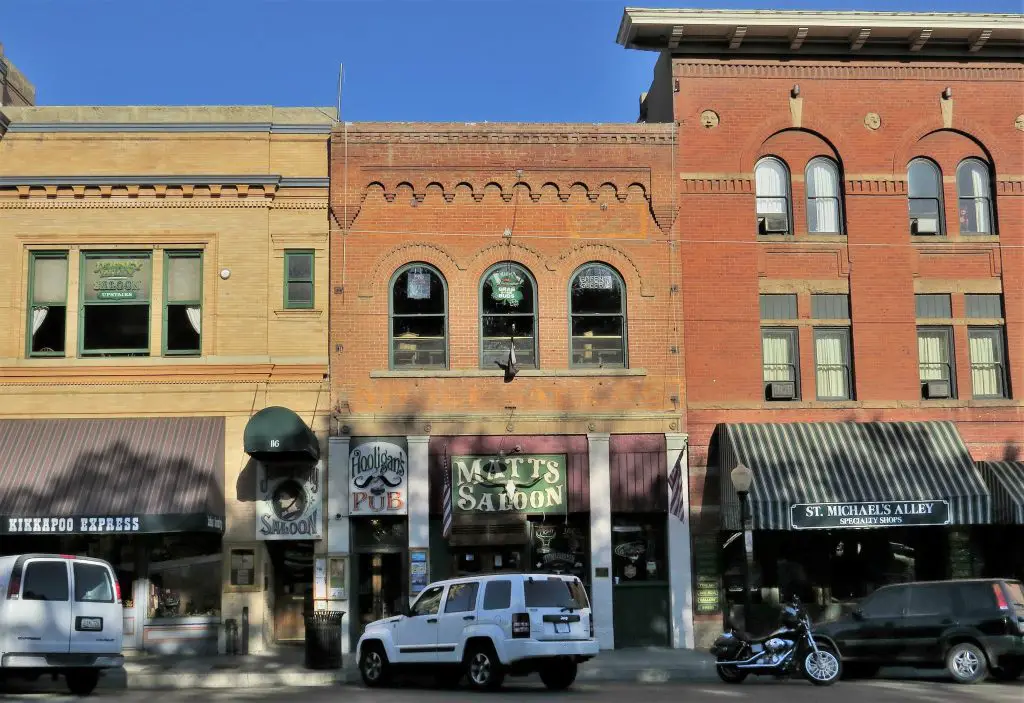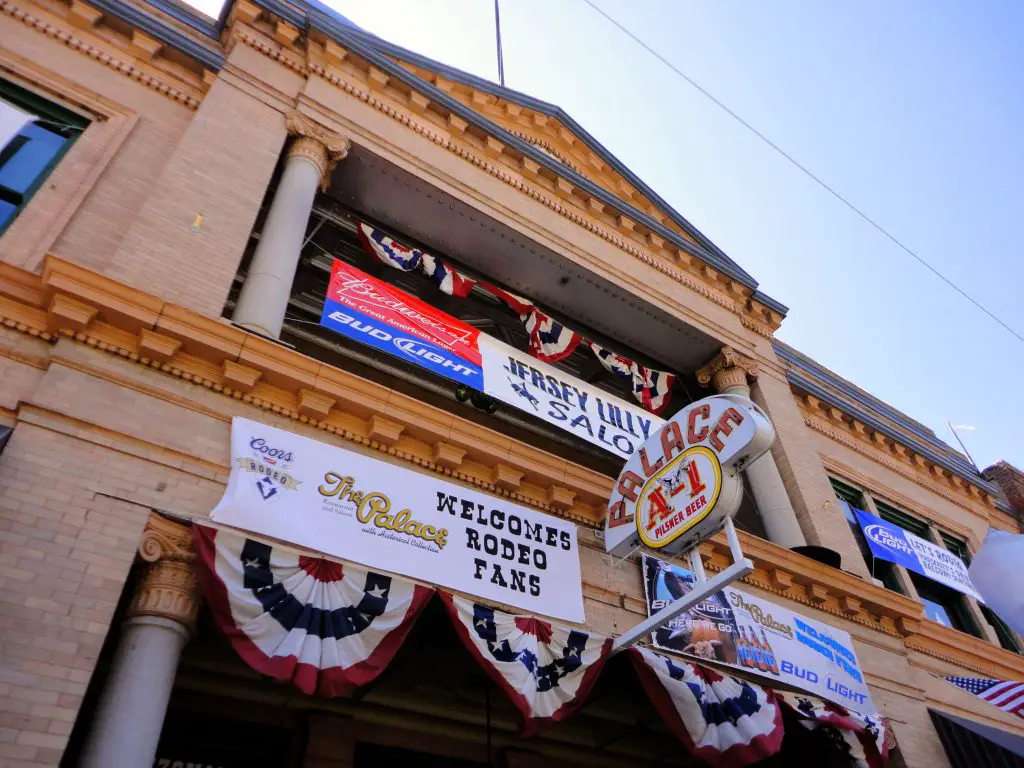Prescott, Arizona, has a storied past, filled with tales of gold miners, cowboys, and settlers trying to make their way in the newly formed state. Established in 1864, Prescott served as the territorial capital of Arizona, a hub for mining activities, and a vibrant cultural center.

The transformation of Prescott into a bustling city was a complex process. Rich with natural resources, the city attracted a diverse population that brought about a blend of traditions, economic activities, and social dynamics.
Whiskey Row is more than just a street in Prescott; it’s a symbol of the city’s heritage. Dating back to the 1800s, this legendary block was once home to as many as 40 saloons, becoming the heart of entertainment and social life in Prescott. The origin of its name, though contested, reflects the central role that whiskey and other spirits played in the life of the town.
Here on Whiskey Row, miners, cowboys, and travelers found a place to unwind, make friends, and enjoy the pleasures of the frontier. This bustling stretch of South Montezuma Street held everything from theaters to gambling halls, making it a crucial part of the city’s social fabric.
The significance of Whiskey Row extends beyond Prescott’s boundaries. As an embodiment of the wild frontier spirit, it represents a chapter in American history that has become emblematic of the nation’s identity. Whiskey Row tells a story of adventure, innovation, and determination, traits that continue to resonate with the American psyche.
Whiskey Row’s fame has reached far and wide, inspiring artists, writers, and even filmmakers. Its influence can be seen in the works of authors like Zane Grey, who often depicted the rugged life of the frontier, including places similar to Whiskey Row. The street is also featured in various historical documentaries, cementing its place in American cultural heritage.
The Birth of Whiskey Row
The birth of Whiskey Row dates back to the late 1800s, coinciding with Prescott’s early development as a booming mining town. With the influx of miners, prospectors, and settlers, the demand for entertainment and social venues grew.
Whiskey Row emerged as a lively stretch along Montezuma Street, lined with saloons, gambling halls, and various establishments catering to the diverse population. Its name, “Whiskey Row,” became synonymous with the numerous bars and spirited atmosphere that characterized the street.
Tragically, a fire in 1900 destroyed much of the original Row, but it was quickly rebuilt, reflecting the community’s resilience. The rebirth of Whiskey Row solidified its place in Prescott’s history, setting the stage for its enduring legacy as a hub of social life, culture, and commerce.
The Gold Rush Era and its Influence
The mid-1800s were marked by a surge of gold prospecting in the American West. Arizona was no exception, with gold discoveries near Prescott leading to a rush of miners and settlers to the area. This Gold Rush brought a diverse mix of people and set the stage for a bustling community.
The growth in population led to an increased demand for entertainment and relaxation, especially for the miners who sought relief after laboring in the mines. This gave rise to the establishments that would later form Whiskey Row, a stretch of entertainment venues that catered to the various needs of the booming population.
Establishment of Saloons and Entertainment Centers
The first saloons in Prescott appeared around the late 1860s, offering more than just drinks. They became social centers, providing meals, games, music, and a place for people to gather and connect. Whiskey Row’s saloons were known for their lively atmosphere, with piano music, dancing, and the clinking of glasses forming a constant backdrop.
The saloons were more than mere watering holes; they were places where deals were struck, friendships were forged, and the community came together. The Palace Saloon, one of the most famous establishments on Whiskey Row, still stands as a testament to this lively era, offering visitors a glimpse into the past.
Connection to the Wild West Mythos
Whiskey Row became a symbol of the Wild West, an era defined by lawlessness, opportunity, and rugged individualism. The street’s saloons, gambling halls, and theaters captured the essence of this mythical time, embodying the spirit of freedom and adventure that marked the frontier era.

Stories of gunfights, gambling legends, and charismatic characters have added to Whiskey Row’s mystique. People like “Big Nose Kate” and Wyatt Earp frequented the Row, contributing to its reputation as a place where legends were made.
Prescott’s walking tours today include Whiskey Row, giving visitors a taste of its rich history and the legends that still echo in its buildings.
Whiskey Row’s Architectural Brilliance
Whiskey Row’s architectural brilliance lies in its blend of historic charm and functional design. The street is lined with well-preserved buildings, many dating back to the late 19th and early 20th centuries, showcasing styles ranging from Victorian to Western frontier.
Distinctive features such as ornate façades, wooden balconies, and decorative brickwork contribute to its unique aesthetic. Adaptive reuse has allowed these architectural treasures to accommodate modern businesses while retaining their historical integrity.
Whiskey Row’s architectural heritage not only adds to its visual appeal but also serves as a tangible connection to Prescott’s past, a physical manifestation of history that resonates with both residents and visitors alike. It’s a streetscape that invites exploration and appreciation, a testament to architectural creativity and preservation.
Victorian and Classical Design Elements
The buildings along Whiskey Row showcase a rich architectural heritage. During the late 19th century, Victorian styles were prevalent, and many buildings were adorned with intricate woodwork, decorative cornices, and ornamental facades.
Simultaneously, there was a blend of classical elements, reflecting the cultural influences of the time. From the grand entrances of the saloons to the detailed design of the theaters, the architecture of Whiskey Row was a fusion of form and function, creating an aesthetically appealing streetscape that still captures the imagination.
The Fire of 1900 and Rebuilding Efforts
Disaster struck Whiskey Row in 1900 when a massive fire ravaged the street, destroying many of its iconic buildings. But the community’s spirit was unbroken. Within days of the fire, rebuilding efforts began, and Whiskey Row’s resilience shone through.
New structures were built with more durable materials like brick, preserving the architectural essence while adding a layer of protection against future fires. The reconstruction of Whiskey Row is a testament to the determination and innovation of Prescott’s people, reflecting a collective commitment to preserving this vital part of the city’s heritage.
Preservation of Historic Buildings
Today, Whiskey Row stands as a symbol of Prescott’s commitment to historical preservation. Several of the street’s buildings are listed on the National Register of Historic Places, emphasizing their architectural and historical significance.
Organizations like the Prescott Heritage Foundation have been instrumental in maintaining the integrity of these structures. Efforts include adaptive reuse, restoration, and advocacy, ensuring that Whiskey Row continues to be a living connection to the past. The preservation of these historic buildings is not merely about maintaining bricks and mortar but about honoring a unique cultural legacy that resonates with residents and visitors alike.
Social and Cultural Impact
Whiskey Row has been a focal point of social and cultural life in Prescott since its inception. Throughout its history, it has served as a gathering place for community celebrations, a venue for political discourse, and a hub for artistic expression.
The saloons, shops, and establishments along the Row have welcomed a diverse array of patrons, fostering connections across different backgrounds and walks of life. Whether in the bustling days of the Wild West or the modern era, Whiskey Row has been a symbol of Prescott’s community spirit and cultural vibrancy.
Its enduring appeal and ever-changing character reflect the city’s values, identity, and heritage, making it a treasured part of Prescott’s social fabric.
The Role in Social Gatherings
In the days of the Wild West, Whiskey Row was the place to be. Saloons were not just about drinks; they were social centers where people from all walks of life gathered. Miners, cowboys, business people, and travelers converged on Whiskey Row to celebrate, discuss, and connect.
Special events, dances, and community gatherings were common occurrences. Whether it was a festive celebration or a somber gathering in times of loss, Whiskey Row was where the community came together, reinforcing bonds and creating shared memories.
Music, Dance, and Festivals
Whiskey Row’s saloons were alive with the sound of music. From piano players to live bands, music was an integral part of the experience. Dance floors were packed, and the tunes of the time resonated through the street, adding to its lively atmosphere.
The tradition of music and dance continues today with festivals like the Prescott Bluegrass Festival and regular live performances at venues along Whiskey Row. The music isn’t just entertainment; it’s a continuation of a cultural tradition that has spanned generations.
Influence on Literature and Arts
The allure of Whiskey Row has extended beyond its physical boundaries, inspiring writers, painters, and artists. Its unique blend of frontier charm, historical significance, and vibrant social life has made it a muse for creative minds.

Authors have woven tales inspired by the characters and events of Whiskey Row, capturing its essence in novels and poems. Artists have painted its landscapes, and photographers have found endless inspiration in its architectural details. A visit to The Phippen Museum in Prescott reveals art inspired by the region, including Whiskey Row’s influence.
Education and Community Building
Whiskey Row has also played a role in community building and education. Historic tours, school visits, and community programs have turned Whiskey Row into a living classroom, where residents and visitors can learn about Prescott’s history, architecture, and cultural heritage.
Community events, fundraisers, and social initiatives often find a home on Whiskey Row, reinforcing its role as a central gathering place. It’s a space where history meets the present, fostering a sense of belonging and continuity that continues to shape Prescott’s identity.
Whiskey Row During the Prohibition Era
During the Prohibition Era (1920–1933), Whiskey Row in Prescott faced a tumultuous period as the sale, manufacture, and transportation of alcoholic beverages were banned across the United States. Many of the saloons that had thrived during the late 19th and early 20th centuries were forced to close or transform into other establishments.
Despite this, whispers of secret speakeasies and illicit activity permeated the street. Whiskey Row’s reputation as a hub for entertainment and socializing endured, but the era left an indelible mark, symbolizing a time of significant social change and legal challenges in the community.
It remains an intriguing chapter in the complex history of this iconic street.
Impact on Saloons and Entertainment Venues
The introduction of Prohibition led to an immediate shift in Whiskey Row’s dynamic. Saloons, once the lifeblood of the street, had to find new ways to survive. Some turned into soda shops or restaurants, while others became clandestine speakeasies, continuing to serve alcohol in secret.
Entertainment venues also had to adapt, focusing more on music, dance, and other forms of entertainment. Whiskey Row’s resilience during this time is a testament to the entrepreneurial spirit and adaptability of its business owners and the community’s desire to preserve its unique character.
Speakeasies and the Underground Scene
Despite Prohibition, the demand for alcohol did not vanish. Secret bars, known as speakeasies, sprang up along Whiskey Row. Hidden behind unmarked doors and requiring passwords for entry, these establishments continued to serve the community’s thirst for social gathering and entertainment.
Speakeasies became symbols of rebellion and a challenge to the status quo. The underground scene on Whiskey Row was more than just about drinking; it was about maintaining a way of life, a social fabric that had defined the community for generations.
The End of Prohibition and Revival
With the repeal of Prohibition in 1933, Whiskey Row began a new chapter. Saloons reopened, and the street regained its status as Prescott’s entertainment hub. The revival was not just a return to business; it was a reaffirmation of Whiskey Row’s cultural significance.
The Prohibition era left an indelible mark on Whiskey Row, adding to its mystique and character. Today, the tales of speakeasies and resilience during Prohibition are an integral part of Whiskey Row’s narrative, reflecting a complex period that shaped its modern identity.
Prohibition’s Lasting Influence
The legacy of Prohibition is still felt on Whiskey Row. From themed bars that pay homage to the speakeasy era to historical markers and tours that highlight this fascinating period, Prohibition’s influence permeates the street’s culture.
The lessons of resilience, adaptability, and the community’s commitment to preserving its heritage continue to resonate. A visit to Matt’s Longhorn Saloon, one of Whiskey Row’s iconic venues, offers a glimpse into this storied past, blending history with contemporary entertainment.
Whiskey Row Today: Modern Significance
Whiskey Row continues to be a vibrant part of Prescott’s community. While preserving its rich history, the Row has embraced the modern era, becoming a hub for locals and tourists alike.
Whiskey Row has evolved into one of Prescott’s top tourist destinations. Its blend of historical charm and modern amenities attracts visitors from around the world. From exploring the historic Palace Saloon to enjoying a meal at one of the many contemporary restaurants, there’s something for everyone.
Walking tours, festivals, and events continue to draw crowds, celebrating Whiskey Row’s unique place in American history. It’s a must-see location for anyone interested in the Wild West, architecture, or simply enjoying a lively street filled with entertainment.
Economic and Business Hub
Whiskey Row is not just a relic of the past; it’s a thriving economic center. The businesses along the street contribute significantly to Prescott’s economy, offering a mix of dining, shopping, entertainment, and more.
New businesses have found a home on Whiskey Row, integrating modern trends while respecting the historical context. The synergy between old and new has created a dynamic environment that continues to attract investment and growth.
Community Gathering Spot
For the residents of Prescott, Whiskey Row remains a central gathering place. The street is not just for tourists; it’s where locals celebrate, gather for events, and enjoy a night out.
Community festivals, parades, and gatherings are often hosted on Whiskey Row, reinforcing its role as a communal space. It’s a place where history meets everyday life, fostering a sense of connection and continuity that transcends generations.
Environmental Stewardship and Sustainability
Whiskey Row’s commitment to the future is also reflected in initiatives aimed at environmental stewardship and sustainability. Many businesses have embraced eco-friendly practices, from recycling to energy conservation.
The preservation and adaptive reuse of historic buildings are inherently sustainable practices, conserving resources, and maintaining cultural heritage. Whiskey Row’s approach to sustainability aligns with a broader community commitment to environmental responsibility.
Economic Contributions
Whiskey Row has been a significant source of employment and business opportunities in Prescott. The wide variety of establishments, ranging from restaurants and bars to shops and galleries, provides a diverse array of jobs. New businesses continue to find a welcoming environment on the Row, contributing to Prescott’s thriving economy.
As one of Prescott’s main attractions, Whiskey Row draws tourists from across the country and the world. The influx of visitors has a substantial impact on local businesses, boosting sales and creating additional employment opportunities.
The tourism industry associated with Whiskey Row not only adds to the local economy but also promotes Prescott as a desirable travel destination.
The economic contributions of Whiskey Row extend beyond its borders. The businesses on the Row collaborate with local suppliers, supporting other sectors within Prescott. Additionally, the taxes and revenues generated contribute to public services and infrastructure.
Overall, Whiskey Row’s economic impact is vital to the financial health and development of Prescott.
Preservation and Modern Transformation
Whiskey Row’s charm lies in its historic buildings, many of which have been adaptively reused. By repurposing these structures for modern businesses while preserving their architectural integrity, Whiskey Row has managed to blend history with functionality. This approach reflects a commitment to sustainability and heritage conservation.
The combination of historic preservation and modern transformation has created a unique and vibrant streetscape on Whiskey Row. Contemporary establishments coexist with preserved landmarks, offering a rich experience that appeals to various tastes and interests. The balance between old and new is a hallmark of Whiskey Row’s identity.
Community members and local organizations have played a crucial role in Whiskey Row’s preservation. Grassroots efforts, public-private partnerships, and ongoing advocacy have ensured that Whiskey Row remains a cherished part of Prescott’s heritage. The community’s involvement underscores a collective value placed on history and culture.
Controversies and Challenges
Whiskey Row’s development and preservation have not been without controversy. Balancing economic growth with historical preservation has led to legal battles and moral dilemmas. Conflicts over property rights, zoning regulations, and the direction of development have sometimes brought tensions to the fore.

Environmental stewardship is another area where Whiskey Row faces challenges. The demand for modern amenities must be balanced with sustainable practices. Issues related to waste management, energy consumption, and conservation are ongoing concerns that require careful consideration.
Perhaps the most significant challenge facing Whiskey Row is the ongoing debate between development and preservation. Finding the right balance between economic growth and maintaining the historical and cultural integrity of the Row is a complex task.
It’s a conversation that involves business owners, residents, government, and tourists, reflecting the multifaceted significance of Whiskey Row in Prescott’s history.
FAQ:
In this section, we will be delving into some of the most common inquiries and curiosities that surround our topic.
What exactly is Whiskey Row?
Whiskey Row is a famous street in Prescott, Arizona, known for its historic saloons, architecture, and cultural significance. It’s a lively hub for locals and tourists alike, offering a blend of history, entertainment, dining, and more.
Why is it called Whiskey Row?
The name “Whiskey Row” dates back to the late 19th and early 20th centuries when the street was home to numerous saloons. The concentration of bars led to its nickname, reflecting its reputation as a center for social gatherings and entertainment.
How can I experience Whiskey Row’s history?
You can explore Whiskey Row’s history through guided walking tours, visiting historic sites like the Palace Saloon, and attending events and festivals that celebrate its heritage. Many businesses also display historical photos and artifacts.
What are some must-visit places on Whiskey Row?
Whiskey Row offers a variety of attractions, including the Prescott Brewing Company, Matt’s Longhorn Saloon, art galleries, boutique shops, and more. Each place offers a unique blend of history and modern charm.
How has Whiskey Row changed over time?
Whiskey Row has evolved from its origins as a row of saloons to a vibrant street that embraces both history and modernity. It has survived fires, Prohibition, and urban development, adapting to changes while preserving its unique character.
Is Whiskey Row family-friendly?
Yes, Whiskey Row offers attractions for all ages, from historical tours to family-friendly restaurants and shops. While it retains its saloon heritage, it has become a multifaceted destination that welcomes families and visitors of all kinds.
Conclusion
The Significance of Whiskey Row in Prescott’s history is multifaceted and enduring. It’s a living connection to the past, a vibrant hub in the present, and a symbol of resilience and adaptability. From its architectural brilliance to its social and cultural impact, Whiskey Row reflects the very essence of Prescott.
Its blend of history and modernity makes it a unique destination that resonates with locals and tourists alike. The preservation of its historic buildings, its role as a community gathering spot, and its evolution into a thriving business center speak to a collective commitment to honoring heritage while embracing the future.
Whiskey Row stands as a testament to Prescott’s character and a reminder that history is not static; it’s a dynamic force that continues to shape our communities. Whether you’re raising a toast in one of its historic saloons or strolling down the street, you’re part of Whiskey Row’s ongoing story.



Leave a Comment
You must be logged in to post a comment.